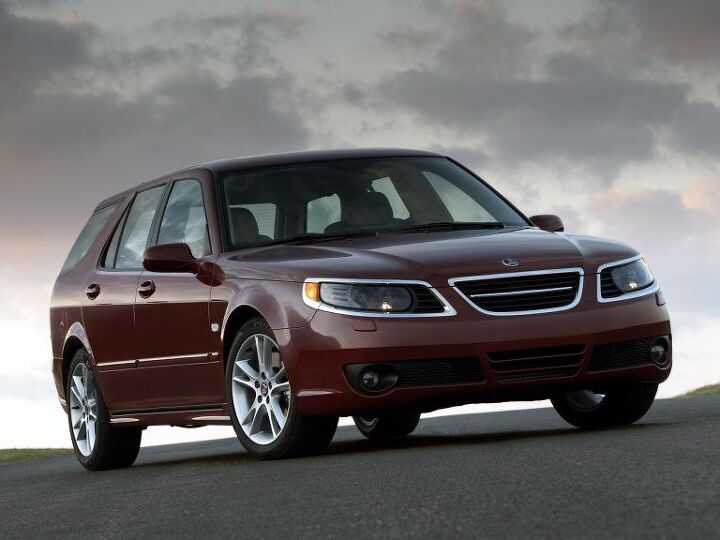QOTD: Alternative History of Avoiding Disastrous Consequences?

Last week we played a round of Armchair Alternative History where we discussed missed opportunities in the automotive industry. Conversation focused on actions automakers didn’t take when they should’ve.
Today is round two. Let’s go back and erase things that actually happened.
Some of you branched out into this topic last week in the 270-plus comments the article received. Today you’ll just have to pick a different past mistake to erase. No one covered your author’s selected misstep for this week.
This one had “AVOIDABLE” written on it in red paint.
1989: General Motors decides not to get involved with Saab
In 1989, Saab (cars) and Scania (trucks) were a single large company. The company restructured itself so the more profitable trucks were separated from the struggling automotive branch. The newly independent Saab Automobile AB needed some assistance, and it leaned on two new capitally-rich owners: Investor AB and General Motors, each with 50 percent ownership. Investor AB was (and is) a private equity firm controlled by the same family since 1916. Typically its investments are in large Swedish-based companies. Though it only has about 80 employees, the firm is worth over $30 billion. General Motors, a much different sort of company, spent $600 million, just like Investor AB. The investment came with an understanding that GM could purchase the remaining stake in the company within 10 years. It did so in 2000, at a cost of $125 million more (quite a discount).
It never should’ve happened. Though the new GM-based 900 was successful and caused the company to turn a profit, Saab was a story of continual struggle. With quirky ideas, unique engineering, and a small following, it was a bad match for the Costco management style of GM. By late in 2008 the brand’s future was in doubt among all of GM’s financial troubles. From there it was sold multiple times, split up, and finally rendered defunct in 2012. NEVS made some electric Saab 9-3s for a while, but those didn’t really count.
In my alternative history, the Saab brand goes to Investor AB and some other firm, probably in China. Eventually wholly Chinese-owned, Saab is just a name for cars that would normally be called Roewe or Great Wall. The company’s last real vehicles were the 900 and 9000, which lived until circa 2002 with minor revisions. Here, General Motors saves itself some money, and does not dilute the final chapter of Saab with things like the Trollblazer 9-7X, and the Saabaru 9-2X.
What’s your historical automotive misstep to erase?
[Images: Saab]

Interested in lots of cars and their various historical contexts. Started writing articles for TTAC in late 2016, when my first posts were QOTDs. From there I started a few new series like Rare Rides, Buy/Drive/Burn, Abandoned History, and most recently Rare Rides Icons. Operating from a home base in Cincinnati, Ohio, a relative auto journalist dead zone. Many of my articles are prompted by something I'll see on social media that sparks my interest and causes me to research. Finding articles and information from the early days of the internet and beyond that covers the little details lost to time: trim packages, color and wheel choices, interior fabrics. Beyond those, I'm fascinated by automotive industry experiments, both failures and successes. Lately I've taken an interest in AI, and generating "what if" type images for car models long dead. Reincarnating a modern Toyota Paseo, Lincoln Mark IX, or Isuzu Trooper through a text prompt is fun. Fun to post them on Twitter too, and watch people overreact. To that end, the social media I use most is Twitter, @CoreyLewis86. I also contribute pieces for Forbes Wheels and Forbes Home.
More by Corey Lewis
Latest Car Reviews
Read moreLatest Product Reviews
Read moreRecent Comments
- SCE to AUX "...to help bolster job growth and the local economy"An easy win for the politicians - the details won't matter.
- Kjhkjlhkjhkljh kljhjkhjklhkjh so now we will PAY them your tax money to build crappy cars in the states ..
- SCE to AUX Yes, I'll miss it, and it doesn't make sense to kill off your 3rd-best seller. 2023 was its best year since 2018.
- SCE to AUX This was the same car I had (05 xB, stick, "camouflage" color) for 7 years - great car.We called ours "The Lunchbox". I added aftermarket wheels, and the 3rd-party cruise control the dealers could install.It suffered only two failures: bad window switch in week 2 (dealer fixed in 1 hour), bad trailing O2 sensor (fixed myself for $70). Fuel economy was always 28-34 mpg.It was a potential death trap, and ride quality became unbearable after 2 hours. I once did a 10-hour round trip in it and could barely walk after.Traded it for a 2012 Leaf, which was a better car in some ways.
- Bd2 The "e" nomenclature signifies the e-ATPs which BMW is pursuing.



































Comments
Join the conversation
Another from GM. What if Chevy had not gone the air cooled, rear engine route with the Corvair and had instead introduced a conventional front engine, rwd compact in the fall of 1959?
What if Chevy gave it a good rear suspension. It sells better, Detroit gets into the small car game earlier, Nader never writes "Unsafe at any Speed", remains unknown, and the Lions share of the 97,421 votes he got in Florida in 2000 likely go to Gore. Not injecting Politics...just pointing out that one had some serious ripple effects for years to come lol.